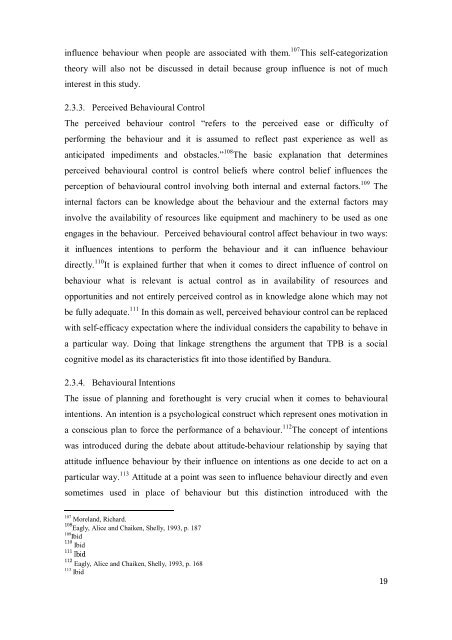A QUANTITATIVE APPROACH TO PREDICT ... - SuSanA
A QUANTITATIVE APPROACH TO PREDICT ... - SuSanA
A QUANTITATIVE APPROACH TO PREDICT ... - SuSanA
Create successful ePaper yourself
Turn your PDF publications into a flip-book with our unique Google optimized e-Paper software.
influence behaviour when people are associated with them. 107 This self-categorization<br />
theory will also not be discussed in detail because group influence is not of much<br />
interest in this study.<br />
2.3.3. Perceived Behavioural Control<br />
The perceived behaviour control “refers to the perceived ease or difficulty of<br />
performing the behaviour and it is assumed to reflect past experience as well as<br />
anticipated impediments and obstacles.” 108 The basic explanation that determines<br />
perceived behavioural control is control beliefs where control belief influences the<br />
perception of behavioural control involving both internal and external factors. 109 The<br />
internal factors can be knowledge about the behaviour and the external factors may<br />
involve the availability of resources like equipment and machinery to be used as one<br />
engages in the behaviour. Perceived behavioural control affect behaviour in two ways:<br />
it influences intentions to perform the behaviour and it can influence behaviour<br />
directly. 110 It is explained further that when it comes to direct influence of control on<br />
behaviour what is relevant is actual control as in availability of resources and<br />
opportunities and not entirely perceived control as in knowledge alone which may not<br />
be fully adequate. 111 In this domain as well, perceived behaviour control can be replaced<br />
with self-efficacy expectation where the individual considers the capability to behave in<br />
a particular way. Doing that linkage strengthens the argument that TPB is a social<br />
cognitive model as its characteristics fit into those identified by Bandura.<br />
2.3.4. Behavioural Intentions<br />
The issue of planning and forethought is very crucial when it comes to behavioural<br />
intentions. An intention is a psychological construct which represent ones motivation in<br />
a conscious plan to force the performance of a behaviour. 112 The concept of intentions<br />
was introduced during the debate about attitude-behaviour relationship by saying that<br />
attitude influence behaviour by their influence on intentions as one decide to act on a<br />
particular way. 113 Attitude at a point was seen to influence behaviour directly and even<br />
sometimes used in place of behaviour but this distinction introduced with the<br />
107 Moreland, Richard.<br />
108 Eagly, Alice and Chaiken, Shelly, 1993, p. 187<br />
109 Ibid<br />
110 Ibid<br />
111 Ibid<br />
112 Eagly, Alice and Chaiken, Shelly, 1993, p. 168<br />
113 Ibid<br />
19
















